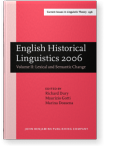The convergence of two need verbs in Middle English
This paper is concerned with OE and ME need v.1, ‘compel, force’ and need v.2, ‘be necessary, need’. It analyses a 2.4 million-word corpus of OE and ME with regard to three factors: relative frequency of both verbs in the two periods, their syntactic properties, and their semantic implications, which are interpreted in terms of Force-Dynamics (cf. Sweetser 1990; Talmy 2000). The results show that, counter-intuitively, need v.2 ‘be necessary, need’ alone is not the only etymological ancestor of PDE semi-modal need, since no clear boundary can be drawn between the two verbs in the periods under analysis. This is most evident in Middle English, when both verbs fully converge syntactically and semantically. Consequently, and most importantly, I show that both need v.1 and need v.2 play a role in the development of PDE need (cf. also Molencki 2002; van der Auwera & Taeymans 2004; Loureiro-Porto 2005b).
Cited by (2)
Cited by two other publications
Nevalainen, Terttu, Tanja Säily, Turo Vartiainen, Aatu Liimatta & Jefrey Lijffijt
2020.
History of English as punctuated equilibria? A meta-analysis of the rate of linguistic change in Middle English.
Journal of Historical Sociolinguistics 6:2

LOUREIRO-PORTO, LUCÍA
2010.
Verbo-nominal constructions of necessity withþearfn. andneedn.: competition and grammaticalization from OE to eModE.
English Language and Linguistics 14:3
► pp. 373 ff.

This list is based on CrossRef data as of 11 july 2024. Please note that it may not be complete. Sources presented here have been supplied by the respective publishers.
Any errors therein should be reported to them.
